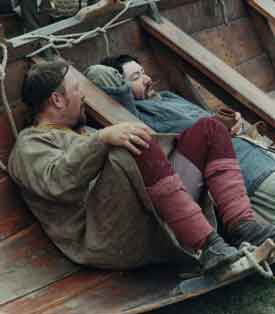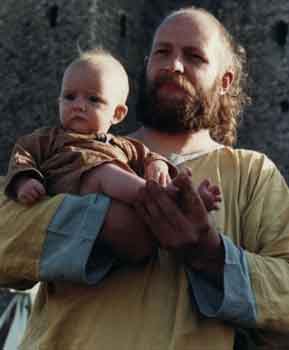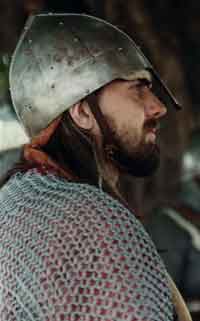Viking social structure conformed to the Indo-European pattern by dividing people into classes; the rulers, the free and the unfree. This situation prevailed through the Vendel and Viking periods and was only significantly altered in the 11th century with the advent of unified kingdoms in the Scandinavian homelands.

Lowest in the social order were the thralls (male-thrall; female-ambatt) or slaves. Whilst the main sources for slaves were war, piracy and trade, their numbers also included those born into slavery and various criminals. A man who failed to discharge his debts could become the slave of his creditor until he redeemed his debt. Thralls had few rights and could hold no land, so instead of being fined for lawbreaking they were beaten, maimed or even put to death. However, a thrall did have some advantages over the freeman as the following laws show:
'Now a freeman and a slave who commit theft together, it is the freeman who is a thief and the slave shall not lose by it, for the man who steals with another man's slave steals by himself.'
'A slave has greater rights than a freeman in one matter. A slave has the right to kill on account of his wife even though she is a bondmaid, but a freeman has not the right to kill on account of a bondmaid, even though she is his woman.'
Despite these advantages, the slave was still only considered chattel, as shown by other laws:
'If a man's slave is killed , then no levelling oath need be sworn for him any more than for any other cattle belonging to a man, should that be killed.'
'If a master kills his own slave, he is not liable before the law unless he kills him during legally ordained festivals or in Lent, then the penalty is banishment.'
Although thralls legally commanded no wergild it was normal in England to pay the owner the price of eight cows if you killed his thrall; in Iceland the equivalent was eight ounces of silver; in Scandinavia the killer must make 'restitution according to the value set on him [the slave] naked.'
Although unable to hold land a thrall could have possessions, money and time to do work for himself. Slaves were permitted to do business at public markets and to make private transactions if the value involved was less than oneortug (1/3 ounce of silver, 20 pence). In favourable circumstances he might hope to purchase, earn or be rewarded with his freedom. Marriage was permitted but the children would also be slaves. Ill treatment of thralls was regarded as an undesirable quality and most masters appear to have treated their slaves quite well. A slave was not allowed to bear arms except in the case of fighting off invaders; and the slave who killed such an enemy was to be rewarded with his freedom.

As the Viking Age wore on, and the influence of Christianity grew stronger, slavery became less common, especially with slaves of the same nationality or religion. Once released the freedman ( leysingi) was still not entirely free; he was still dependant on his former owner and family for a number of generations and could not institute legal proceedings against him. He needed a patron to protect his new found freedom and often looked to his former master to champion him. He could however gain full freedom by buying it with a larger payment than would otherwise be required. Alfred's treaty with Guthrum at Wedmore in 886 AD set the wergild of a Danish freedman equal to that of a Saxon gebur (who sat roughly in the middle of society in the Ceorl class) at two hundred shillings.
Above the freedman were the bondi and karls, the truly free land holding farmers. This class was a very broad one ranging from impoverished peasants to men of wealth and local authority. Whilst they could be sailors, hunters, traders or raiders they were still fundamentally farmers, even if absence and large holdings meant they required the labour of other men - both free and thrall. Their wergild at Wedmore was set as the same as English nobility, eight half-marks of pure gold.
Although in theory a bondi had a farm of his own, in practice most young men had to live with their parents, or farm the lands of a large landholder. Such men still retained their status.
'These were the men who tilled land and raised stock, bore witness and produced verdicts, said aye or no on matters of public concern at the Thing (including matters as important as the election of a king or a change of religion), attended religious and lay ceremonies, made and bore weapons, manned ships, served in levies, were conscious of their dues and worth, and so impressed these upon others that as a free peasantry they stood in a class of their own in Europe.'
One stage above the bondi were those landowners with hereditary rights to their land. In Orkney, Shetland and the Western Isles these were known as odalsbondi, in Norway as hauldr, and in England as holdas. Odal rights were fiercely maintained as they distinguished a family claim, and could not be usurped by jarls or even the crown (in Scotland odal rights survived into the eighteenth century!). The weregild for a Holdas was established in English courts as half that for an eolderman.
The upper levels of Viking society were comprised of the various forms of aristocracy and the kings. The lowest rank of rulers were the landsmenn (roughly equivalent to the later medieval 'baron'), known as styraesmen in Denmark. Originally the individual ship commanders, the later qualification for this rank was the ability to field and maintain forty armed men in the levy. The position was not hereditary and was gained through an oath of loyalty to the king, on whose behalf they held their authority. In Norway their 'manbote' (weregild) was fixed at six full marks of silver.

More frequently encountered is the title of jarl, a semi or fully independent lordship. As with the bondi some held lands by odal right of inheritance, others ruthlessly fought their way to power. In the early period there is little clear difference between powerful jarls and the many petty kings who flourished in Denmark and Norway. Later, in the eleventh century, under kings such as Harald Hardrada, the power-broking jarls were crushed. The Viking captain with his fleet and hirð was a thing of the past. The new chieftains were landed men who wished for stability and peace, members of a bondi aristocracy who supported centralised kingship. In the century after Harald Fairhair, no Norwegian king died peacefully in his bed or was succeeded by his son. Magnus became king in 1035 at the invitation of the people and came to peace with his uncle Hardrada. Hardrada's death in 1066 was not the fault of his subjects, and his sons, grandson and great-grandsons all succeeded him in due order. The power and organisational abilities of the Christian Church also aided the king, to their mutual benefit.
This influence increased throughout the eleventh century. As power centralised the royal estates were left in the charge of stewards, bryti, who formed a layer of local authority balancing that of the local landsmenn.
Although under Scandinavian influence the Danelaw was an integral part of the English kingdom. Like the rest of England it was divided into shires, some massive like Yorkshire and Lincolnshire, others far smaller. The larger shires were divided into 'trithings' (a Scandinavian word for thirds) which gives us our modern 'ridings' in Yorkshire. The Midland shires and the shires of the south-east Danelaw conformed to the usual English patterns, as did the East-Anglian divisions of Norfolk and Suffolk.
Much of the Danelaw, like the rest of England, was further subdivided into hundreds, and the basic fiscal and disciplinary business of the community passed through the hundred courts. However, where Scandinavian influence was strongest, such as Yorkshire and the Five Boroughs, the equivalent sub-division was the wapentake. Despite the differences in nomenclature of the sub-divisions, the legal system was much the same. Even in Scandinavia the legal system was not vastly different to that in England. The only major differences were in religion and, as the Danes were converted, even this difference grew less. This does not mean that the laws were identical, however, as one of Edgar's codes permitted the Danes to exercise their rights 'according to the good laws they can best decide on.'
The wapentakes were further subdivided into the Danish carucates, the land that could be ploughed by one plough team in a year, and bovates, the amount of land apportioned to a farmer contributing one ox to the eight-ox plough team. In Nottinghamshire, Lincolnshire and Norfolk, traces of a further Scandinavian sub-division are to be found - the manslot (allotment to one free settler). Hundreds were still divided into hides.
It is not clear exactly how warriors were recruited for the Here (army). It is likely that they may have been drawn on the 'one man from several basic land units' as was done in Saxon areas.
Click here to return to the village.